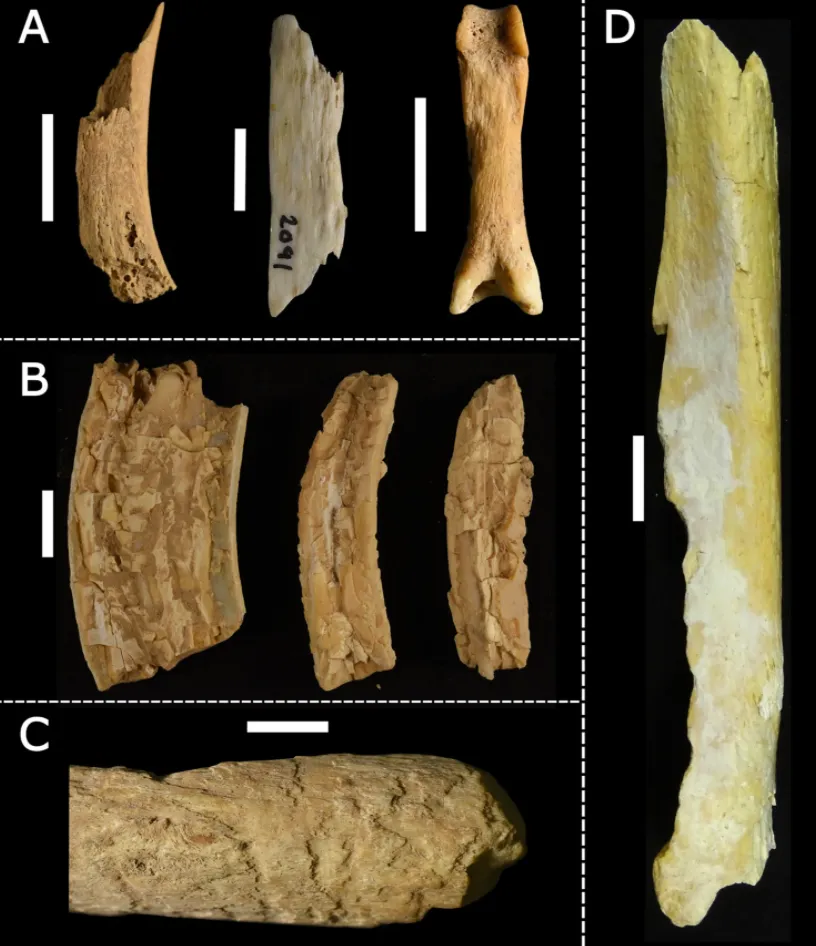Hyenas Hoarded Thousands of Human, Animal Bones in Saudi Arabian Lava Tube
The huge stockpile includes camel, rodent and cattle remains
:focal(784x533:785x534)/https://tf-cmsv2-smithsonianmag-media.s3.amazonaws.com/filer/e0/41/e04128cf-06a7-475d-81f3-4882399acda2/3f32e97832e81a209e418f6d69e6274c.jpeg)
Archaeologists in northwestern Saudi Arabia have unearthed a massive collection of bones likely stockpiled by striped hyenas over the past 7,000 years.
Found in the Umm Jirsan lava tube system—a sprawling network of tunnels formed by volcanic activity—the hundreds of thousands of bones belong to at least 14 kinds of animals, including cattle, caprids, horses, camels, rodents and even humans. The researchers’ findings are newly published in the journal Archaeological and Anthropological Sciences.
Lead author Mathew Stewart, a zooarchaeologist at the Max Planck Institute for the Science of Human History in Germany, tells Gizmodo’s Isaac Schultz that the team identified hyenas as the culprits after analyzing cuts, bites and digestion marks found on the bones.
“Striped hyena are very avid accumulators of bones,” Stewart says.
Researchers have been investigating the site, which is located in the country’s Harrat Khaybar lava field, since 2007. But they only ventured into the cavern’s depths a few months ago. (Per Gizmodo, another group of archaeologists reported hearing possible hyena snarls in the tubes, prompting them to keep their distance.)
For the study, the team analyzed 1,917 bones and teeth recovered from the lava tube. Radiocarbon dating of a small number of these samples found that they ranged in age from around 439 to 6,839 years old, suggesting “a long use of the lava tube system by carnivores,” per the paper.
In a Twitter thread quoted by Al Arabiya English’s Joanne Serrieh, Stewart notes that hyenas transport bones “to dens to be consumed, fed to young or cached.” The study adds that the carnivores engage in both hunting and scavenging activities, killing some animals while simply hoarding the remains of others.
A key sign that hyenas were responsible for the huge pile of bones was the presence of human skull fragments. The mammals are notorious for rummaging through graves for grub.
“It’s always just the skullcap that survives,” Stewart tells Gizmodo. “[Hyenas] seem to not really be interested in skull caps. We found maybe five or six skullcaps with gnaw marks on them at the site, but only the skullcaps. Nothing else.”
Lone hyenas typically snack on dead animals. But packs prefer to hunt, targeting prey like antelopes, hares, rodents and birds.
Happy to introduce the Umm Jirsan lava tube, Saudi Arabia, in our new paper just out in AAS.
— Stewie Stewart (@StewieStewart13) July 21, 2021
This 1.5 km long lava tube is chock-a-block with hundreds of thousands of beautifully preserved animal remains. But why? (1/n)https://t.co/BMTYTxR4da pic.twitter.com/ubCTLHVyPX
Umm Jirsan is far from the only example of hyenas stockpiling huge assemblages of bones. As Riley Black wrote for National Geographic in 2010, the Srbsko Chlum-Komin Cave in the Czech Republic contains more than 3,500 well-preserved large mammal bones collected by the carnivores.
The new study took place as part of the Palaeodeserts Project, which seeks to track human and animal migration across the Arabian Peninsula. Saudi Arabia’s harsh weather makes this task difficult: Hot conditions can make bones break down, and some ancient remains actually disintegrate when touched.
“The most surprising thing comes down to just how well preserved the material is, and how much material there is, given that in Saudi we have no faunal remains, really,” Stewart tells Gizmodo.
In the Twitter thread, Stewart lauds the lava tube’s “excellent conditions for preservation of bone.”
He adds, “Umm Jirsan (and other similar sites in the region) is likely to hold valuable insights into the ecologies and environments of Holocene Arabia. This study is just the tip of the iceberg.”
/https://tf-cmsv2-smithsonianmag-media.s3.amazonaws.com/accounts/headshot/Isis_Davis-Marks_thumbnail.png)

/https://tf-cmsv2-smithsonianmag-media.s3.amazonaws.com/filer/93/13/9313e6cb-e90e-4cf4-b5fb-56c2ebb35c6c/screen_shot_2021-08-05_at_100735_am.png)
/https://tf-cmsv2-smithsonianmag-media.s3.amazonaws.com/accounts/headshot/Isis_Davis-Marks_thumbnail.png)